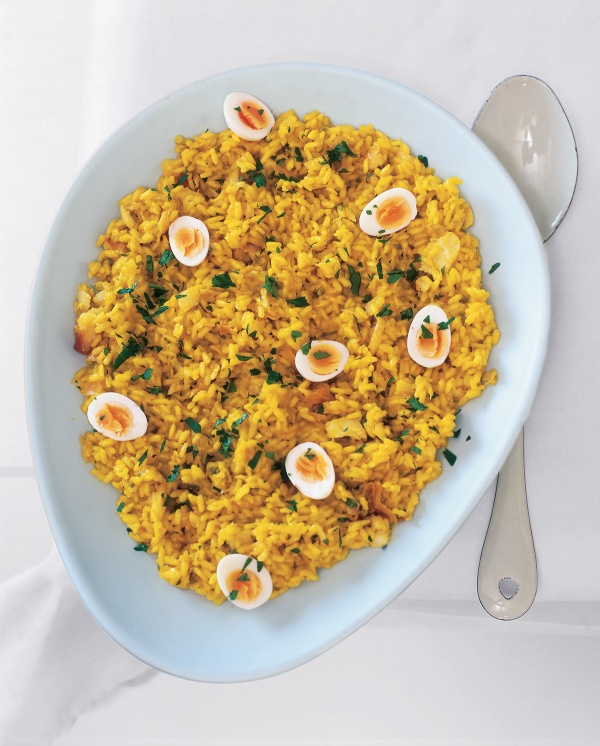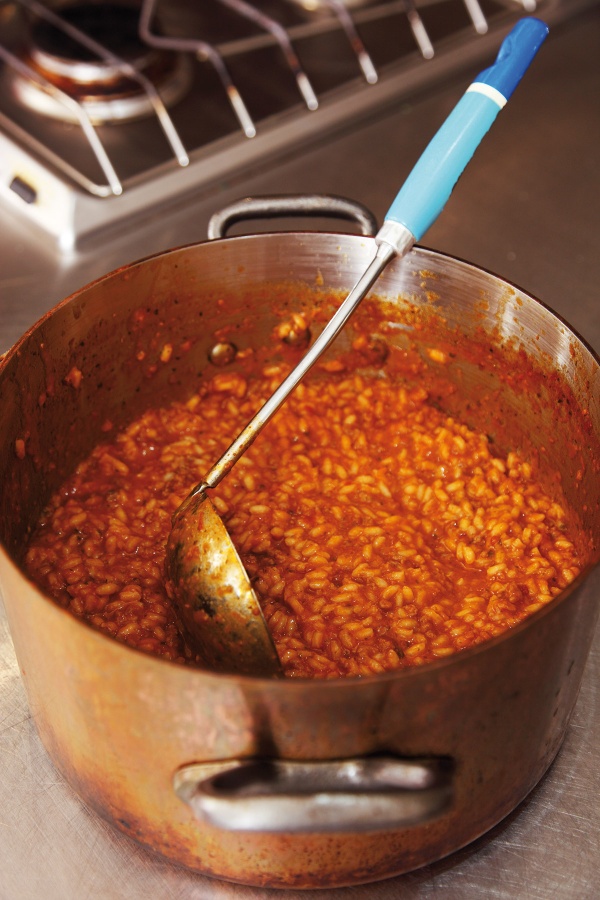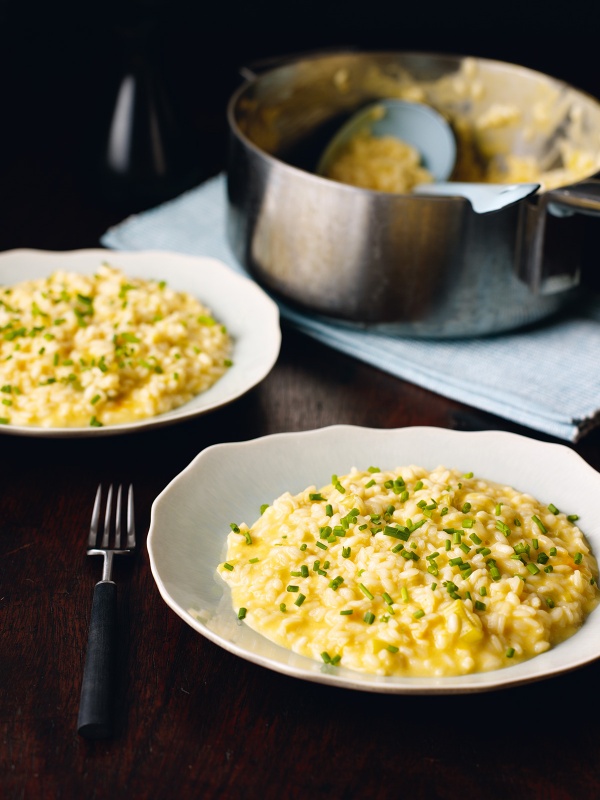Kedgeree Risotto
by Nigella. Featured in FEASTIntroduction
This is a strange hybrid of a recipe: kedgeree cooked as if it were a risotto, that is to say Anglo-Indian influence, Italian method. I admit, however, that Italians may look askance at this recipe: after all, it calls on spices entirely alien to the Italian kitchen. But it's long been an Easter favourite of mine, and I stoutly defend it!
And please read the Additional Information section at the end of the recipe before proceeding.
Read moreThis is a strange hybrid of a recipe: kedgeree cooked as if it were a risotto, that is to say Anglo-Indian influence, Italian method. I admit, however, that Italians may look askance at this recipe: after all, it calls on spices entirely alien to the Italian kitchen. But it's long been an Easter favourite of mine, and I stoutly defend it!
And please read the Additional Information section at the end of the recipe before proceeding.
Read more
Share or save this
Ingredients
Serves: 2-4
- 285 grams smoked haddock
- pepper
- 1 bay leaf
- ¼ teaspoon ground mace
- 1 sprig fresh parsley
- 1 vegetable stock cube or concentrate or powder
- 500 millilitres water
- 40 grams butter
- ½ teaspoon vegetable oil
- 1 leek
- 300 grams arborio rice
- ¼ teaspoon ground cumin
- ¼ teaspoon ground coriander
- ¼ teaspoon turmeric
- zest of 1 lemon (plus 1 teaspoon juice)
- 80 millilitres white wine
- 6 quail's eggs (optional)
- 2 tablespoons freshly chopped fresh parsley
- 10 ounces smoked haddock
- pepper
- 1 bay leaf
- ¼ teaspoon ground mace
- 1 sprig fresh parsley
- 1 vegetable broth cube or concentrate or powder
- 2 cups water
- 2½ tablespoons butter
- ½ teaspoon vegetable oil
- 1 leek
- 1½ cups arborio rice
- ¼ teaspoon ground cumin
- ¼ teaspoon ground coriander
- ¼ teaspoon turmeric
- zest of 1 lemon (plus 1 teaspoon juice)
- ⅓ cup white wine
- 6 quail's eggs (optional)
- 2 tablespoons freshly chopped fresh parsley
Method
- Cut the haddock into two or more pieces to fit into a frying pan (preferably one with a lid). Add some pepper, the bay leaf, blade of mace, if you have one, and sprig of parsley, and pour over the water. Cover the pan with a lid, or some tightly sealed foil, and bring to the boil. Turn down and simmer the haddock for 3-5 minutes so that the fish is cooked through but not falling apart. Remove with a slotted spatula and wrap the haddock in foil and reserve the liquid from the pan, straining it into a measuring jug. Make the liquid in the jug up to the 1 litre / 4 cup mark with boiling water and add the vegetable broth granules or cube or whatever you're using. Pour this liquid into a saucepan and put over a low heat.
- On a nearby burner, in a fairly wide saucepan, heat 30g / 2 tablespoons of the butter and the oil. Trim the leek, and then finely slice it into circles, adding it to the oily pan. Cook gently for about 5 minutes until the leek softens. Add the rice to the pan and turn well in the buttery oil until slicked and glossy then stir in the spices and lemon zest. Turn up the heat and add the wine, stirring until it is bubblingly absorbed. Then add a ladleful of the reserved fish cooking liquid mixed with vegetable stock in its nearby saucepan, stirring until it too is absorbed then proceed ladleful by ladleful until the rice is cooked and sticky — about 20 minutes — and the liquid is used up or nearly all used up. You probably don't need me to remind you, but let me anyway: it is important that each ladleful is absorbed before you add the next one.
- Meanwhile, put the quail's eggs in a pan of cold water and bring to the boil. Once the water's come to the boil, drain the eggs and put them in a bowl of cold water, running the tap for a while over them to make sure they stop cooking.
- Once you have reached the right point with the risotto, and the rice is done, add the fish, minimally flaked with a fork or your fingers, to the rice along with the remaining butter and the lemon juice, beating well, off the heat, with your wooden spoon to make sure everything is creamy and well amalgamated. Spoon the risotto on to a large plate so that it is fairly flat, add the peeled and halved quails eggs au choix and sprinkle with the parsley.
- Cut the haddock into two or more pieces to fit into a frying pan (preferably one with a lid). Add some pepper, the bay leaf, blade of mace, if you have one, and sprig of parsley, and pour over the water. Cover the pan with a lid, or some tightly sealed foil, and bring to the boil. Turn down and simmer the haddock for 3-5 minutes so that the fish is cooked through but not falling apart. Remove with a slotted spatula and wrap the haddock in foil and reserve the liquid from the pan, straining it into a measuring jug. Make the liquid in the jug up to the 1 litre / 4 cup mark with boiling water and add the vegetable broth granules or cube or whatever you're using. Pour this liquid into a saucepan and put over a low heat.
- On a nearby burner, in a fairly wide saucepan, heat 30g / 2 tablespoons of the butter and the oil. Trim the leek, and then finely slice it into circles, adding it to the oily pan. Cook gently for about 5 minutes until the leek softens. Add the rice to the pan and turn well in the buttery oil until slicked and glossy then stir in the spices and lemon zest. Turn up the heat and add the wine, stirring until it is bubblingly absorbed. Then add a ladleful of the reserved fish cooking liquid mixed with vegetable stock in its nearby saucepan, stirring until it too is absorbed then proceed ladleful by ladleful until the rice is cooked and sticky — about 20 minutes — and the liquid is used up or nearly all used up. You probably don't need me to remind you, but let me anyway: it is important that each ladleful is absorbed before you add the next one.
- Meanwhile, put the quail's eggs in a pan of cold water and bring to the boil. Once the water's come to the boil, drain the eggs and put them in a bowl of cold water, running the tap for a while over them to make sure they stop cooking.
- Once you have reached the right point with the risotto, and the rice is done, add the fish, minimally flaked with a fork or your fingers, to the rice along with the remaining butter and the lemon juice, beating well, off the heat, with your wooden spoon to make sure everything is creamy and well amalgamated. Spoon the risotto on to a large plate so that it is fairly flat, add the peeled and halved quails eggs au choix and sprinkle with the parsley.
Additional Information
For gluten free check the stock cube or concentrate is gluten free.
MAKE AHEAD / STORE:
It is not advisable to make ahead or store.
For gluten free check the stock cube or concentrate is gluten free.
MAKE AHEAD / STORE:
It is not advisable to make ahead or store.






Tell us what you think
Thank you .
Explore more recipesYour comment has been submitted.
What 3 Others have said
Wow! This is amazing. I love how you can detect the spices but they aren't overpowering. I've been asked to cook this again which I definitely will be doing!
My husband and I love this recipe. The risotto method of cooking allows the spices to get into the rice, unlike the traditional way of making kedgeree. This gives the kedgeree a much deeper flavour.
What a great recipe combining the anglo indian traditional flavours and the italian method. Kedgeree has always been a favourite of mine.... will try this for Good Friday dinner..... I like to serve with hot mango chutney!